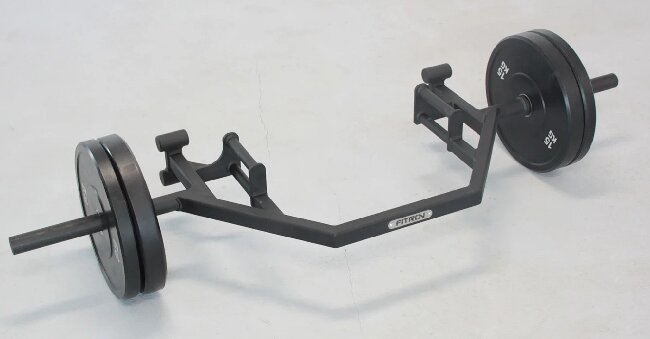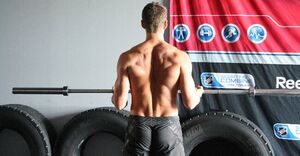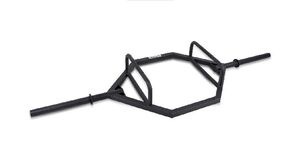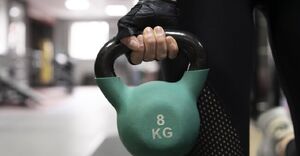
How to Use Trap Bars for Deadlifts: A Comprehensive Guide
If you’re looking to take your deadlift game to the next level, incorporating trap bar deadlifts into your routine may be just the ticket.
In this comprehensive guide, we’ll break down everything you need to know about trap bars – from their benefits to proper form and common mistakes to avoid.
Whether you’re a beginner or a seasoned lifter, we’ve got you covered on how to set up for trap bar deadlifts, maintain proper form, and progress in your training. So, grab your trap bar and let’s get lifting!
What is a Trap Bar?
A trap bar, also known as a hex bar, is a specialized piece of weightlifting equipment commonly used for deadlifts in strength training. It has a unique shape that allows for a more ergonomic lifting position compared to traditional barbells.
This design feature of the trap bar helps reduce strain on the lower back and places less stress on the shoulders, making it a popular choice for those looking to target their lower body muscles effectively. In addition to deadlifts, trap bars can be used for exercises like farmer’s walks, shrugs, and even overhead presses, providing versatility in strength training routines. The neutral grip handles on a trap bar also offer better wrist and shoulder alignment, promoting safer and more efficient lifting techniques for various fitness levels.
What Are the Benefits of Using a Trap Bar for Deadlifts?
Using a trap bar for deadlifts offers several benefits that contribute to overall strength gains and injury prevention. It targets key muscle groups in the lower body and core, making it a valuable exercise for athletes and fitness enthusiasts.
The unique design of the trap bar allows for a more upright torso position during deadlifts, reducing strain on the lower back and promoting better form. This not only helps in preventing injuries but also enhances overall muscle engagement. Incorporating the trap bar into your routine can lead to improved power output and performance, as it allows for a greater load to be lifted while minimizing stress on the joints. All these factors combine to make the trap bar a versatile and effective tool for enhancing strength and athletic performance.
Reduced Strain on the Lower Back
Using a trap bar for deadlifts can help reduce strain on the lower back by promoting proper form and muscle activation. This can be particularly beneficial for individuals with lower back issues.
The unique design of the trap bar allows for a more upright torso position, which shifts some of the stress from the lower back to the legs and glutes. By engaging these larger muscle groups, the risk of overloading the lower back is significantly decreased.
The neutral grip handles of the trap bar provide a more natural hand position, enhancing overall stability and control during the lift. Proper muscle activation not only reduces the chance of injury but also ensures that the targeted muscles are effectively engaged for maximum strength and growth.
Increased Muscle Activation
One of the key benefits of using a trap bar for deadlifts is the increased muscle activation it offers. This can lead to greater strength gains in various muscle groups, including the back, legs, and core.
When performing deadlifts with a trap bar, the unique design and grip positioning can effectively engage the muscles in the posterior chain, such as the glutes, hamstrings, and lower back. By distributing the weight more evenly, the trap bar allows for a more upright torso position, which can help in reducing stress on the lower back while still targeting the desired muscle groups. The added muscle activation from using a trap bar can also translate to improved overall performance and functional strength in daily activities.
Easier to Learn and Perform
Compared to traditional barbell deadlifts, using a trap bar is often easier to learn and perform due to its ergonomic design and grip variations. This makes it a suitable choice for beginners and those looking to perfect their deadlift technique.
The trap bar, also known as a hex bar, allows users to stand within its center, which can promote a more natural alignment for the body during the lift. The grip variations on a trap bar provide more options for hand placement, catering to individual preferences and body mechanics. This makes it easier to maintain proper form and reduce the risk of injury while still maximizing muscle engagement. The versatility of the trap bar makes it a versatile tool for strength training and a valuable addition to any workout routine.
How to Properly Set Up for Trap Bar Deadlifts
Properly setting up for trap bar deadlifts is crucial to ensure a safe and effective workout. This involves selecting the right equipment, maintaining proper form, and incorporating essential tips for optimal performance.
- To begin, choose a trap bar that is suited to your height and strength level. When setting up the bar, ensure that it is positioned flat on the ground with the handles aligned parallel to your body.
- Stand inside the bar with your feet hip-width apart, toes slightly pointing outwards. Keep your core engaged, back straight, and shoulders pulled back.
As you grip the handles, maintain a neutral spine position throughout the lift. Remember to drive through your heels, using the power of your legs and hips to lift the bar, rather than relying solely on your lower back. It’s also important to exhale as you lift and inhale as you lower the bar to maintain proper breathing technique.
By following these setup steps correctly, you can maximize the benefits of trap bar deadlifts and reduce the risk of injury.
Positioning the Bar
Positioning the trap bar correctly before starting your deadlifts is crucial for maintaining proper alignment and engaging the targeted muscle groups effectively. Ensuring that the bar is centered and at the right height is essential for a successful lift.
When setting up for trap bar deadlifts, it is important to have your feet shoulder-width apart and your hips pushed back to maintain a strong and stable base. The proper grip on the bar, with hands positioned slightly wider than shoulder-width, helps in distributing the weight evenly and reduces strain on the wrists. Paying attention to your back posture, keeping it straight and bracing your core, is vital to prevent injury and maximize the engagement of your glutes, hamstrings, and lower back muscles.
Gripping the Handles
The way you grip the handles of a trap bar during deadlifts can impact your form, muscle activation, and overall performance. Proper grip strength and positioning are essential for a secure and effective lift.
Maintaining a solid grip on the trap bar not only enhances your stability and control throughout the movement but also plays a key role in engaging the muscles in your forearms. By focusing on your grip technique, you can effectively recruit additional muscles, such as the flexors and extensors in your forearms, leading to improved overall muscle activation. This increased muscle engagement not only aids in lifting heavier weights but also promotes better forearm strength development, which is crucial for optimizing your trap bar deadlift performance.
Positioning Your Feet
Proper foot positioning when using a trap bar for deadlifts is crucial for maintaining form and engaging the lower body muscle groups effectively. Ensuring a stable base and proper weight distribution can enhance the lifting experience.
It is important to note that the placement of your feet impacts how efficiently you can perform the movements. By positioning your feet shoulder-width apart and ensuring that your weight is evenly distributed between both feet, you are setting yourself up for a solid foundation. This not only aids in stability but also minimizes the risk of injury. The engagement of the posterior chain, including the glutes, hamstrings, and lower back, is heightened when foot placement is correct, leading to more significant muscle activation during the lift.
Proper Form for Trap Bar Deadlifts
Maintaining proper form during trap bar deadlifts is essential to maximize core strength, athletic performance, and minimize the risk of injuries. By focusing on form cues and technique, lifters can optimize their deadlifts for superior results.
Proper form in trap bar deadlifts not only helps in targeting specific muscle groups effectively but also plays a crucial role in enhancing overall strength and stability. A solid core is the foundation for all movements, and trap bar deadlifts are no exception. Engaging the core throughout the lift not only protects the lower back but also improves posture and balance.
This emphasis on core activation leads to improved athletic performance, providing a strong base for explosive movements and better force transfer. Correct form reduces the likelihood of strains and injuries, ensuring longevity and sustainability in training programs.
Maintaining a Neutral Spine
One of the key components of proper form in trap bar deadlifts is maintaining a neutral spine throughout the movement. This helps to engage the core effectively and protect the back muscles from strain.
A neutral spine alignment not only supports the core muscles but also distributes the weight more evenly across the body, reducing the risk of injury. By keeping the spine neutral, individuals can ensure that the load is properly distributed, allowing for optimal muscle engagement and power generation. This optimal alignment also facilitates better breathing control and balance during the lift, ultimately improving overall stability and performance in trap bar deadlifts.
Engaging Your Core
Engaging your core muscles is essential for stability and power during trap bar deadlifts. By activating the abdominal muscles, you can enhance your lifting performance and protect your lower back.
Maintaining a strong core while performing trap bar deadlifts not only helps in stabilizing your body, but it also plays a crucial role in promoting proper form throughout the movement.
Core engagement ensures that your body stays aligned and balanced, reducing the risk of injury and allowing you to lift heavier weights effectively. The abdominal muscles act as a supportive foundation, transferring force efficiently from the lower body to the upper body.
This integration of core strength into your trap bar deadlift routine can lead to improved overall fitness and functional strength.
Driving Through Your Heels
When performing trap bar deadlifts, it’s crucial to drive through your heels to engage the lower body muscles effectively. This movement pattern helps distribute the weight evenly and maximize muscle activation.
By focusing on pushing through the heels, you ensure that the powerful muscles of your glutes, hamstrings, and quadriceps are fully activated, providing strength and stability throughout the lift. Proper alignment of your form is essential to prevent any unnecessary strain on your lower back.
Driving through the heels allows you to maintain a strong and stable base, enabling you to lift heavier weights safely while promoting a balanced weight distribution.
Common Mistakes to Avoid
To ensure a safe and effective trap bar deadlift workout, it’s important to avoid common mistakes that may increase the risk of injury. By understanding and correcting these errors, lifters can optimize their training experience.
One common mistake often made during trap bar deadlifts is rounding the back. This can lead to excessive strain on the spine and increase the likelihood of back injuries. It’s crucial to maintain a neutral spine throughout the movement to protect the lower back.
Improper foot placement, such as having feet too narrow or too wide, can affect balance and stability. Experts recommend positioning the feet shoulder-width apart to ensure proper alignment and distribution of weight.
Ensuring proper hip hinge technique is also crucial in preventing injuries and maximizing the effectiveness of the trap bar deadlift.
Rounding the Back
Rounding the back during trap bar deadlifts can significantly increase the risk of lower back injuries. It’s crucial to maintain a neutral spine and proper form throughout the lift to protect the back muscles and prevent strain.
Proper form cues include keeping the chest up, shoulders back, and engaging the core muscles to support the spine. Ensure that the hips are not rising faster than the chest during the lift to distribute the weight evenly. Strengthening the posterior chain through exercises like Romanian deadlifts and hyperextensions can also help prevent lower back injuries. Incorporating proper warm-up routines and gradually increasing weights can further reduce the risk of strains and enhance overall performance during trap bar deadlifts.
Not Engaging the Core
Failing to engage the core during trap bar deadlifts can compromise form stability and limit the effectiveness of the exercise. By activating the core muscles, lifters can enhance their strength gains and protect their spine.
Core engagement plays a vital role in trap bar deadlifts as it not only helps maintain proper alignment and stability but also significantly boosts the efficiency of the movement.
When the core is activated, it acts as a solid foundation, allowing the lifter to generate more power through their legs and glutes. Strong core muscles aid in transferring the force generated during the lift, reducing the strain on the lower back and preventing injuries.
Therefore, prioritizing core engagement in trap bar deadlifts is key to maximizing performance and reaping the full benefits of this compound exercise.
Using Too Much Weight
Lifting too much weight on a trap bar can compromise form and increase the risk of injury. It’s essential to prioritize proper form and technique over heavy weights to maximize strength gains and minimize strain.
Ensuring that the body is in the correct position throughout the lift is crucial for preventing unnecessary stress on the back and joints. Gradual progression is key in trap bar deadlifts to allow muscles and connective tissues to adapt and strengthen gradually. Implementing safe lifting practices, such as engaging the core and maintaining a neutral spine, can significantly reduce the likelihood of injuries. Remember, quality repetitions with moderate weight are more beneficial than pushing beyond your capacity and risking potential setbacks.
How to Progress with Trap Bar Deadlifts
Progressing effectively with trap bar deadlifts involves strategic planning of sets, repetitions, and increasing weight over time. By implementing progressive overload and proper progression strategies, lifters can achieve continuous strength gains.
When structuring a training program for trap bar deadlifts, it is crucial to start with a manageable weight that allows for proper form and technique. Beginners can benefit from starting with lighter weights and focusing on mastering the movement before progressing to heavier loads. As strength improves, gradually increase the weight in small increments to continue challenging the muscles.
Utilizing a mix of set and rep schemes such as 3-4 sets of 6-8 reps can help target both strength and muscle endurance. This method keeps the body adapting and growing stronger over time.
Increasing Weight Gradually
Gradually increasing the weight lifted in trap bar deadlifts is key to stimulating muscle growth and strength gains over time. By incrementally challenging the muscles, lifters can achieve progressive improvements in their lifting capacity.
This gradual progression helps in effectively engaging and activating various muscle groups which leads to enhanced muscle stimulation. Consistent progression in weight not only boosts strength gains but also plays a crucial role in adhering to the principle of progressive overload.
This principle is vital for continual muscle adaptation and growth as it ensures that the body is consistently challenged to a higher level of performance. Therefore, incorporating incremental weight increments in trap bar deadlifts is essential for maximizing strength development and muscle hypertrophy.
Adding Variations
Incorporating variations of trap bar deadlifts into your workout routine can target different muscle groups and add variety to your training regimen. By exploring diverse deadlift variations, lifters can enhance overall muscle development and prevent plateaus.
Including trap bar deadlift variations in your workouts can not only help in engaging muscles like the quadriceps, hamstrings, glutes, and lower back comprehensively but also improve functional strength and power. The unique design of the trap bar places less stress on the lower back compared to traditional barbell deadlifts, making it a safer option for individuals with back issues. Incorporating these variations can lead to improved grip strength, core stability, and explosiveness, translating to enhanced athletic performance in various sports and activities.
How to Incorporate Trap Bar Deadlifts into Your Workout Routine
Integrating trap bar deadlifts into your workout routine can significantly contribute to achieving your fitness goals and enhancing strength and conditioning. By strategically incorporating this compound exercise, you can optimize your training outcomes.
Trap bar deadlifts offer a versatile approach to targeting multiple muscle groups simultaneously, making them ideal for individuals looking to build overall strength and improve functional movement patterns.
By adjusting the grip position and stance width, you can tailor the exercise to focus on different areas such as the quads, hamstrings, and glutes. This variability not only adds excitement and challenge to your workouts but also helps prevent plateaus and overuse injuries commonly associated with traditional deadlift variations.
As a Main Lift
Utilizing trap bar deadlifts as a main lift in your training program can enhance athletic performance and overall strength development. By prioritizing this functional movement, athletes can optimize their physical capabilities and performance outcomes.
This exercise targets a wide range of muscle groups, including the lower back, glutes, and quads, promoting balanced and functional strength.
Trap bar deadlifts are considered to be safer than traditional barbell deadlifts as the weight’s placement reduces strain on the lower back. The improved biomechanics of the movement can also help athletes increase their maximal strength and power output, translating into better on-field performance.
Incorporating trap bar deadlifts can provide a well-rounded training stimulus that benefits athletes across various sports disciplines.
As an Accessory Lift
Including trap bar deadlifts as an accessory lift in your workout routine can supplement your strength training regimen and enhance your performance in other exercises. This versatile movement can be utilized to target specific muscle groups and improve lifting capacity.
Trap bar deadlifts are particularly beneficial in CrossFit workouts as they engage multiple muscle groups simultaneously, offering a functional strength challenge. With variations like sumo stance or deficit trap bar deadlifts, you can add diversity to your routine while improving overall strength and stability. Incorporating these lifts can also help prevent injury by strengthening the posterior chain and improving hip hinge mechanics.
Whether you’re a beginner or an experienced lifter, trap bar deadlifts provide a scalable option that can complement your fitness goals effectively.
In a Superset or Circuit
Incorporating trap bar deadlifts in a superset or circuit within your workout routine can enhance core strength, muscle endurance, and overall conditioning. By combining deadlifts with complementary exercises, you can create an efficient and challenging training session.
This form of workout structure not only boosts the benefits of trap bar deadlifts but also adds variety to your regime, keeping your muscles engaged and continuously adapting. By incorporating trap bar deadlifts into a superset or circuit, you’re able to work multiple muscle groups simultaneously, maximizing your time in the gym. The dynamic nature of these compound movements ensures that you are not only targeting your core but also engaging various other muscle groups throughout your body, leading to a well-rounded fitness routine.




No Comments